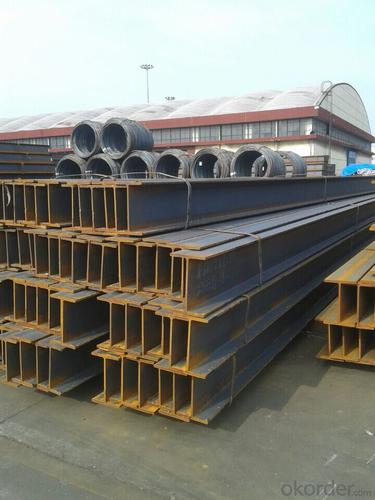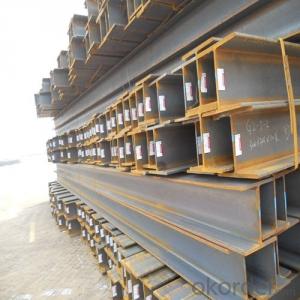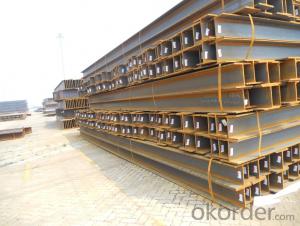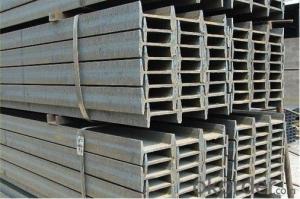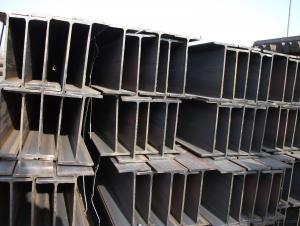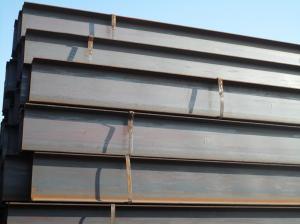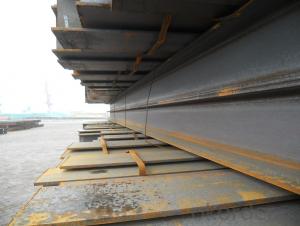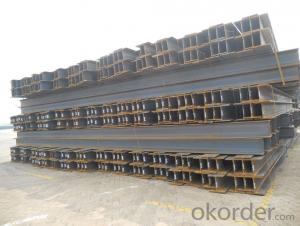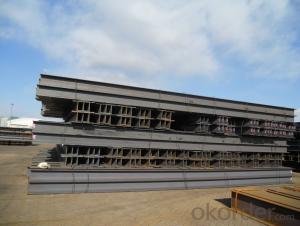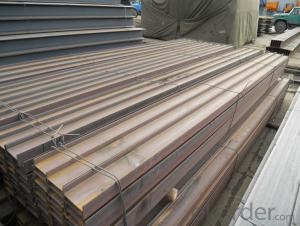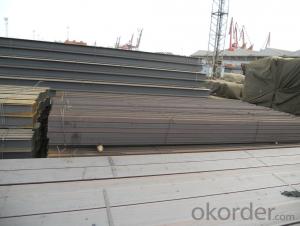Hot Rolled Steel H Beams JIS Standard
- Loading Port:
- Tianjin
- Payment Terms:
- TT OR LC
- Min Order Qty:
- -
- Supply Capability:
- 200000 m.t./month
OKorder Service Pledge
OKorder Financial Service
You Might Also Like
Specifications of Hot Rolled Steel H Beams JIS Standard
1. Standard: JIS
2. Grade: SS400
3. Length: 10m
4. Invoicing on theoretical weight or actual weight as customer request
5.Payment: TT or L/C
6. Sizes:
H x B
(mm)
| T1 | T2 | JIS Weight
(kg/m)
| GB Weight
(kg/m)
|
100*100 | 6 | 8 | 16.9 | 17.2 |
125*125 | 6.5 | 9 | 23.6 | 23.8 |
150*75 | 5 | 7 | 14 | 14.3 |
148*100 | 6 | 9 | 20.7 | 21.4 |
150*150 | 7 | 10 | 31.1 | 31.9 |
175*90 | 5 | 8 | 18 | 18.2 |
175*175 | 7.5 | 11 | 40.4 | 40.4 |
198*99 | 4.5 | 7 | 17.8 | 18.5 |
200*100 | 5.5 | 8 | 20.9 | 21.7 |
194*150 | 6 | 9 | 29.9 | 31.2 |
200*200 | 8 | 12 | 49.9 | 50.5 |
248*124 | 5 | 8 | 25.1 | 25.8 |
250*125 | 6 | 9 | 29 | 29.7 |
244*175 | 7 | 11 | 43.6 | 44.1 |
250*250 | 9 | 14 | 71.8 | 72.4 |
298*149 | 5.5 | 8 | 32 | 32.6 |
298*201 | 9 | 14 | 65.4 |
|
300*150 | 6.5 | 9 | 36.7 | 37.3 |
294*200 | 8 | 12 | 55.8 | 57.3 |
300*300 | 10 | 15 | 93 | 94.5 |
346*174 | 6 | 9 | 41.2 | 41.8 |
350*175 | 7 | 11 | 49.4 | 50 |
340*250 | 9 | 14 | 78.1 | 79.7 |
350*350 | 12 | 19 | 135 | 137 |
400*200 | 8 | 13 | 65.4 | 66 |
390*300 | 10 | 16 | 105 | 107 |
400*400 | 13 | 21 | 172 | 172 |
446*199 | 8 | 12 | 65.1 | 66.7 |
450*200 | 9 | 14 | 77.9 | 79.5 |
440*300 | 11 | 18 | 121 | 124 |
496*199 | 9 | 14 | 77.9 | 79.5 |
500*200 | 10 | 16 | 88.2 | 89.6 |
488*300 | 11 | 18 | 125 | 129 |
596*199 | 10 | 15 | 92.5 | 95.1 |
600*200 | 11 | 17 | 103.4 | 106 |
588*300 | 12 | 20 | 147 | 151 |
700*300 | 13 | 24 | 182 | 185 |
800*300 | 14 | 26 | 207 | 210 |
900*300 | 16 | 28 | 240.1 | 243 |
Usage & Applications of Hot Rolled Steel H Beams JIS Standard
Commercial building structure ;Pre-engineered buildings; Machinery support structure; Prefabricated structure; Medium scale bridges; Ship-building structure.etc.
Packaging & Delivery of Hot Rolled Steel H Beams JIS Standard
1. Packing: it is nude packed in bundles by steel wire rod
2. Bundle weight: not more than 3.5MT for bulk vessel; less than 3 MT for container load
3. Marks:
Color marking: There will be color marking on both end of the bundle for the cargo delivered by bulk vessel. That makes it easily to distinguish at the destination port.
Tag mark: there will be tag mark tied up on the bundles. The information usually including supplier logo and name, product name, made in China, shipping marks and other information request by the customer.
If loading by container the marking is not needed, but we will prepare it as customer request.
4. Transportation: the goods are delivered by truck from mill to loading port, the maximum quantity can be loaded is around 40MTs by each truck. If the order quantity cannot reach the full truck loaded, the transportation cost per ton will be little higher than full load.
5. Delivered by container or bulk vessel
Production flow of Hot Rolled Steel H Beams JIS Standard
Material prepare (billet) —heat up—rough rolling—precision rolling—cooling—packing—storage and transportation
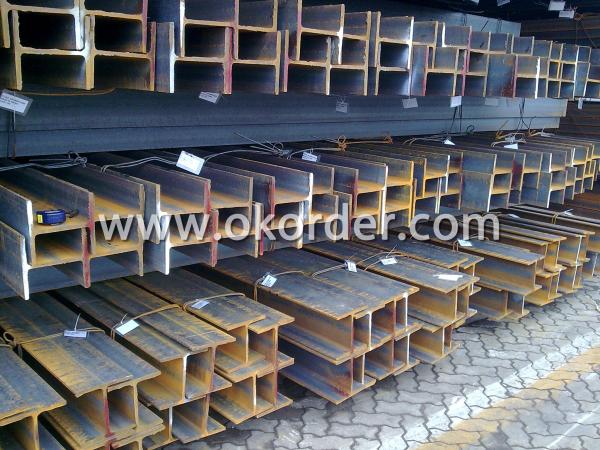
- Q: Can steel H-beams be used for supporting pedestrian bridges?
- Yes, steel H-beams can be used for supporting pedestrian bridges. They are commonly used in construction due to their strength, durability, and ability to withstand heavy loads. Steel H-beams provide structural support and can be designed to meet the specific requirements of pedestrian bridges, ensuring safety and stability.
- Q: How do you calculate the moment of inertia for steel H-beams?
- To calculate the moment of inertia for steel H-beams, you need to determine the dimensions and properties of the beam. The moment of inertia can be calculated using the formula: I = (b * h^3)/12 + 2 * (A * d^2), where b is the width of the flange, h is the height of the flange, A is the area of the web, and d is the distance between the centroid of the flange and the centroid of the web. By plugging in these values, you can calculate the moment of inertia for the steel H-beam.
- Q: Are there any health concerns associated with Steel H-Beams?
- Steel H-Beams can potentially raise health concerns due to their composition. Typically made from carbon steel, which contains trace amounts of lead, chromium, and nickel, these elements can pose health risks if they are released into the environment or individuals come into direct contact with them. One issue to consider is lead poisoning, a serious health condition caused by exposure to this toxic heavy metal. Particularly harmful to children, if lead is present in steel beams and released into the air or water, it can contaminate the surrounding environment and endanger human health. Another worry involves the presence of chromium and nickel. These metals can trigger allergic reactions and skin irritation in sensitive individuals. Direct contact with steel beams containing these elements can result in dermatitis or other skin conditions. Additionally, the production and processing of steel involve the use of various chemicals and substances that can be harmful if not handled and disposed of properly. For instance, the welding process used to fabricate steel beams may release toxic fumes like zinc oxide or manganese, which can negatively impact respiratory health if inhaled. It is crucial to emphasize that the health risks associated with Steel H-Beams can be minimized by following appropriate handling, storage, and disposal practices. Employers and workers who come into contact with steel beams should receive education about potential health hazards and take necessary precautions to safeguard themselves. Furthermore, strict adherence to environmental regulations and safety standards is essential to ensure that steel production processes do not pose any risk to human health or the environment.
- Q: How do steel H-beams compare to timber beams in terms of maintenance requirements?
- Compared to timber beams, steel H-beams offer a clear advantage in terms of maintenance. Unlike timber, steel H-beams are not vulnerable to rot, decay, or insect infestation. They possess exceptional durability and don't necessitate regular inspections or treatments to prevent these issues. Moreover, steel beams resist warping, twisting, and bending, which can occur over time with timber beams due to fluctuations in moisture levels. Consequently, steel H-beams retain their structural integrity for a longer duration without the need for repairs or replacements. In summary, steel H-beams have significantly lower maintenance requirements in comparison to timber beams, making them a more cost-effective and hassle-free choice in the long term.
- Q: Can steel H-beams be customized according to specific project requirements?
- Yes, steel H-beams can be customized according to specific project requirements. Steel H-beams are versatile structural elements that are commonly used in construction projects. They can be customized in terms of size, length, and thickness to meet the specific needs of a project. The customization process involves working closely with steel fabricators to determine the exact dimensions and specifications required for the project. This allows for the creation of H-beams that are tailor-made to fit the specific structural requirements, ensuring optimal performance and safety. Customization options also include surface treatments, such as galvanization or coatings, to enhance durability and corrosion resistance. Overall, steel H-beams offer a high degree of flexibility and can be customized to suit a wide range of project requirements.
- Q: Can steel H-beams be used in the construction of theaters or auditoriums?
- Yes, steel H-beams can be used in the construction of theaters or auditoriums. Steel H-beams are commonly used in construction due to their strength and durability. They provide structural support and are often used as load-bearing elements in building projects. In theaters and auditoriums, where large open spaces and high ceilings are often required, steel H-beams can be used to create the necessary framework and support for the building. Additionally, steel H-beams can be easily fabricated and customized to meet the specific design and structural requirements of the theater or auditorium. Overall, steel H-beams are a popular choice in the construction industry, including for the construction of theaters and auditoriums, due to their strength, versatility, and reliability.
- Q: How do steel H-beams connect to other structural elements?
- Steel H-beams can connect to other structural elements in a variety of ways depending on the specific design and engineering requirements of the project. One common method is through the use of bolts or welds. When connecting to other steel components, such as columns or beams, H-beams are often bolted together using high-strength bolts. These bolts are inserted through pre-drilled holes in the flanges (horizontal top and bottom sections) of the H-beam and then tightened with nuts. This creates a secure and rigid connection between the H-beam and the other structural elements. Welding is another method used to connect steel H-beams to other structural elements. In this case, the flanges of the H-beam are welded to the adjacent components, ensuring a strong and permanent connection. Welding is often preferred in situations where high load-bearing capacity and structural integrity are crucial. In addition to bolts and welds, other connection methods such as connectors or brackets can also be used depending on the specific requirements of the project. These connectors or brackets are often designed to provide additional strength and stability to the connection between the H-beam and other structural elements. It is important to note that the connection method used for steel H-beams depends on various factors, including the load-bearing capacity, structural design, and safety regulations. These factors are carefully considered by structural engineers and designers to ensure that the connection is strong, secure, and able to withstand the forces and loads imposed on the structure.
- Q: Can steel H-beams be used in the construction of cultural complexes or museums?
- Yes, steel H-beams can be used in the construction of cultural complexes or museums. Steel H-beams are commonly used in construction projects due to their strength, durability, and versatility. They provide structural support, allowing for the creation of large open spaces and unique architectural designs. Additionally, steel H-beams can be easily fabricated and assembled, making them suitable for complex and intricate structures often found in cultural complexes or museums.
- Q: Are steel H-beams suitable for use in the construction of sports facilities?
- Steel H-beams are indeed suitable for use in the construction of sports facilities. They are widely utilized in construction owing to their robustness, endurance, and versatility. Their ability to bear heavy loads makes them perfect for providing support to large structures like sports arenas, stadiums, and gymnasiums. Furthermore, H-beams ensure exceptional structural integrity, guaranteeing the safety and stability of the sports facility. Moreover, steel H-beams offer easy fabrication and installation, enabling efficient construction and reduced construction time. All in all, steel H-beams are a dependable and cost-effective option for building sports facilities, effectively meeting the specific requirements and demands of such structures.
- Q: Can steel H-beams be used in airport or terminal construction?
- Yes, steel H-beams can be used in airport or terminal construction. They are commonly utilized in the construction of large structures like airports or terminals due to their high strength, versatility, and ability to support heavy loads. The H-beams provide structural stability and are often used for framing, columns, or support beams in the construction of these buildings.
Send your message to us
Hot Rolled Steel H Beams JIS Standard
- Loading Port:
- Tianjin
- Payment Terms:
- TT OR LC
- Min Order Qty:
- -
- Supply Capability:
- 200000 m.t./month
OKorder Service Pledge
OKorder Financial Service
Similar products
Hot products
Hot Searches
Related keywords



